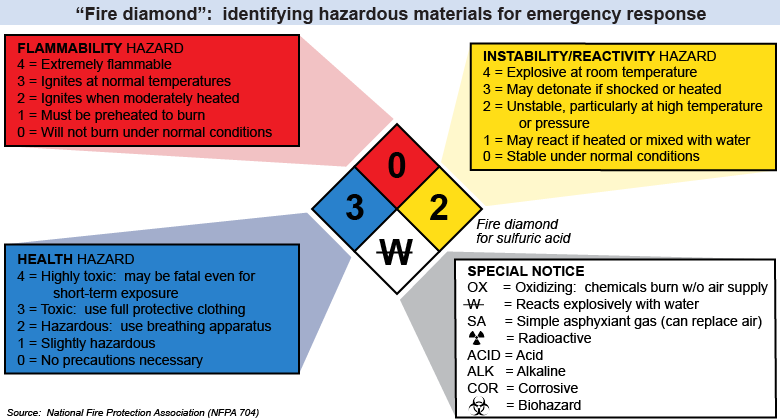|
|
A hazardous material is any substance that poses an unreasonable risk to life, the environment, or property when not properly contained. The Occupational Safety and Health Administration defines a hazardous chemical as any substance that would be a risk to employees if they were exposed to it in the workplace. Common to both of these definitions is that a hazardous material can pose a risk when not handled or stored properly; when proper procedures are followed, however, that risk is minimized. The most important part of handling hazardous materials is to know the protocol for handling them before you try to do so. Learn before you act!
|
 Materials can pose many different types of hazards to life, property, and the environment. You may have seen before one kind of classification: the fire hazards typically associated with transportation of hazardous chemicals. These “fire diamonds” can be recognized easily on the sides of trucks and containers as a set of four diamonds in red, blue, yellow, and white. Each diamond contains a number or abbreviation inside it indicating the degree to which the chemical is a hazard in that way. Zero (0) means that the substance does not pose a hazard under normal conditions; the maximum four (4) indicates that the substance poses an extreme hazard. These standardized symbols have been adopted based on the National Fire Protection Association’s standard #704 (known as NFPA 704).
Materials can pose many different types of hazards to life, property, and the environment. You may have seen before one kind of classification: the fire hazards typically associated with transportation of hazardous chemicals. These “fire diamonds” can be recognized easily on the sides of trucks and containers as a set of four diamonds in red, blue, yellow, and white. Each diamond contains a number or abbreviation inside it indicating the degree to which the chemical is a hazard in that way. Zero (0) means that the substance does not pose a hazard under normal conditions; the maximum four (4) indicates that the substance poses an extreme hazard. These standardized symbols have been adopted based on the National Fire Protection Association’s standard #704 (known as NFPA 704).
 |
The hazard categories identified in the fire diamond are as follows: - Red: flammability hazard. The scale is an indication of the temperature at which the substance can catch fire; a value of four (4) indicates that it is flammable at standard temperature and pressure conditions.
- Blue: health hazard. This indicates what kind of protection is necessary to prevent harm to people when handling the material or cleaning up a spill.
- Yellow: instability or reactivity hazard. This category indicates how volatile the chemical might be to react with other substances and its potential to detonate or explode.
- White: special notice. A chemical might be oxidizing (OX), meaning that it can cause a substance to burn without the need of air. Other chemicals react with water, so if they catch fire they must be put out with a different fire-suppression agent (such as a foam). There are three “official” special notices that are part of the NFPA 704 standard: OX,
W, and SA. Numerous “unofficial” special notices are sometimes used, such as radioactivity and biohazard. Depending on local regulations, use of these unofficial special notices may be required, permitted, or forbidden. 
|
|
Although hazardous chemicals are not part of this curriculum, you should still know how to dispose of any chemicals or other waste you may generate in your laboratory. Never dispose of hazardous chemicals in the regular trash or pour them down the sink; special containers are provided instead. Look for posters, product labeling, or safety data sheets for disposal instructions or ask your teacher.
|
|
Household hazardous waste is composed of post-consumer products that cannot be discarded in the normal waste stream—items that cannot be thrown away in the trash can. Oil-based paint, motor oil, pesticides, fluorescent bulbs, rechargeable batteries, and some electronics (such as mobile phones, computers, and televisions) are all examples of products that should never be dumped into a garbage can. Many cities, towns, and counties have collection locations and times when they accept household hazardous waste.
|
| |
|

